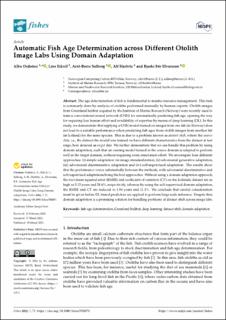| dc.description.abstract | The age determination of fish is fundamental to marine resource management. This task is commonly done by analysis of otoliths performed manually by human experts. Otolith images from Greenland halibut acquired by the Institute of Marine Research (Norway) were recently used to train a convolutional neural network (CNN) for automatically predicting fish age, opening the way for requiring less human effort and availability of expertise by means of deep learning (DL). In this study, we demonstrate that applying a CNN model trained on images from one lab (in Norway) does not lead to a suitable performance when predicting fish ages from otolith images from another lab (in Iceland) for the same species. This is due to a problem known as dataset shift, where the source data, i.e., the dataset the model was trained on have different characteristics from the dataset at test stage, here denoted as target data. We further demonstrate that we can handle this problem by using domain adaptation, such that an existing model trained in the source domain is adapted to perform well in the target domain, without requiring extra annotation effort. We investigate four different approaches: (i) simple adaptation via image standardization, (ii) adversarial generative adaptation, (iii) adversarial discriminative adaptation and (iv) self-supervised adaptation. The results show that the performance varies substantially between the methods, with adversarial discriminative and self-supervised adaptations being the best approaches. Without using a domain adaptation approach, the root mean squared error (RMSE) and coefficient of variation (CV) on the Icelandic dataset are as high as 5.12 years and 28.6%, respectively, whereas by using the self-supervised domain adaptation, the RMSE and CV are reduced to 1.94 years and 11.1%. We conclude that careful consideration must be given before DL-based predictors are applied to perform large scale inference. Despite that, domain adaptation is a promising solution for handling problems of dataset shift across image labs. | |

